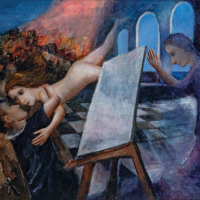42. GARRY SHEAD

Garry Sheads formidable reputation is built on his powerful series of narrative works, rooted in literature and the events of the past. In that he is not unusual, echoing the likes of Sidney Nolan (1917-1992) and the Ned Kelly paintings as milestones in Australian art. The narrative is a form of story-telling in this case a series of paintings that, while unique and self-contained as works of art, contribute to an interpretation of a story. The narrative form is all around us, in the books, articles, essays and narrations in the media and resting on countless bookshelves. A narrative series, made up of works of art, is not strictly comparable to the original telling of the tale, for in most cases that will be a linear progression; the beginning, the middle and the end. Of course some writers will juggle these around, as in many a crime series where the focal event is at the beginning and the ensuing narrative will work backwards, teasing out causes and motivations along the way. The works of Garry Shead, as with any narrative artist, will be absorbed in the order the viewer chooses they might start at the wrong end, or in the middle, or randomly as conditions permit. We have all experienced the gallery exhibition opening where ones progress is activated more by the milling of the crowd and the presence of the drinks waiter, than any fixed narrative sequence.
That Garry Shead should be attracted to such an artistic form is no surprise, for his early works grew from that most elemental of pictorial narratives, the illustrated comic book. His images of The Phantom, the Ghost Who Walks, combined the flat elemental style of the comic artist with other forms of graphic art, most notably the Japanese print. That he began his career drawing cartoons and working for the Australian Broadcasting Commission all contributed to his later desire to work with the great stories of literature and history.
After working through a number of epic themes, most notably DH Lawrences Kangaroo, the Ern Malley Affair and the Queen in Australia, Garry Shead felt he was ready to embrace one of the most powerful and challenging narratives in world literature, Dantes Divine Comedy, completed just before the authors death in 1321, exactly seven hundred years ago. As a story, the Divine Comedy has everything love, loss, horror and redemption, challenging themes enough for a long narrative poem, but especially so for the visual artist attempting to capture the meaning and spirit of the work without falling into the trap of overblown illustration and comic book horror. Artists of every stripe, from Botticelli to Blake and Dali to Rauschenberg have confronted the story, and for an artist with Garry Sheads knowledge of the art of the past, the task to succeed would be heroic.
For Shead, there were personal reasons why he wanted to confront the Divine Comedy; parallels with his own life that could be put to rest if he could successfully place his mark. In the same way he dealt with the complexities of DH Lawrences story in Kangaroo, set in the town of Thirroul, just down the road from the artists seaside home at Bundeena on the edge of the Royal National Park. Sheads wife, the sculptor Judit Englert (1949-2007) had died after a long illness and, after a few years, he began a new relationship. This episode, one of many he had created from Dantes poem, appears to be a key work in linking the story to those events of his own life. The artist reels back in surprise as the new muse, Chagall-like, floats from above to plant a kiss. Off to his right an angelic figure raises an arm in blessing the new relationship is meant to be. On both main figures the finest of white brushstrokes surrounds the head, haloes that cement the blessing and its divine origins. Shead has embraced the spiritual and the mystical in his own life and brings those values to this moving work, one where symbolism and meaning is woven into every aspect, from the flaming image of purgatory on the bushfire encircled hill and the disarray of the artists palette, to the chequerboard flooring of the temple in the sky.
Gavin Fry BA (Hons) MA MPhil